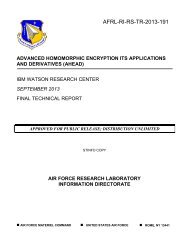EN100-web
EN100-web
EN100-web
You also want an ePaper? Increase the reach of your titles
YUMPU automatically turns print PDFs into web optimized ePapers that Google loves.
Research and Innovation<br />
Dynacargo: An Urban Solid<br />
Waste Collection<br />
Information System<br />
by Artemios G. Voyiatzis and John Gialelis<br />
The aim of the Dynamic Cargo Routing on-the-go<br />
(Dynacargo) project is to optimize the fleet operation for<br />
the city waste collection through urban-scale sensor<br />
networks, delay-tolerant networking, citizen<br />
participation, and dynamic routing.<br />
The Dynamic Cargo Routing on-the-go (Dynacargo) project<br />
aims to develop a state-of-art waste collection information<br />
system that is capable of dynamically optimizing the service<br />
plans of the garbage trucks (vehicle routes) based on the collection<br />
of waste bin fill level information. The project<br />
involves the TEI of Western Greece as a lead partner and the<br />
Industrial Systems Institute of R.C. “Athena” as scientific<br />
partners, two innovative SMEs from the ICT sector<br />
(Mindware and OrasysID), and the Municipality of<br />
Nafpaktia, Greece. The system is tested in the historical city<br />
of Nafpaktos (Lepanto). The project started in September<br />
2013 and concludes in June 2015.<br />
The efficient collection of urban solid waste is a growing<br />
problem for cities and urban areas. Optimized service plans<br />
can save money, reduce emissions, and improve a city’s<br />
image. However, waste bins are still emptied by experience<br />
and ‘a good guess approach’ although the advantages of utilizing<br />
‘actual status information’ are evident [1].<br />
In the Dynacargo project, we seek for applicable solutions at<br />
the whole chain of information collection and diffusion<br />
(Figure 1). At the bin level, we research sensors, mainly<br />
ultrasound, that cope with the harsh environment and can<br />
provide accurate fill level information while randomlyplaced<br />
solid objects of different shapes are placed in the bin.<br />
Given that the bins are installed in the roads or pavements,<br />
battery operation must be assumed and strategies for<br />
longevity must be devised.<br />
At an urban scale of operation, thousands of sensors are<br />
sparsely deployed in the city terrain. System installation and<br />
maintenance, ensuring radio coverage, and retaining network<br />
formation can become an unmanageable task. The<br />
Dynacargo project opts for low-range, point-to-point communications<br />
based on RFID technology so as to cope with<br />
these issues. Vehicles roaming around the city and equipped<br />
with readers collect the information from the bins. In order to<br />
cope with increased telecommunication costs and infrastructure<br />
upgrades, these mobile sinks defer transmissions until<br />
an Internet connection becomes available. The Delay<br />
Tolerant Networking paradigm ensures that the information<br />
is retained in the bins, until a mobile sink passes nearby and<br />
then in the sinks, until an Internet connection is available.<br />
At the information system in the backend, the information<br />
from the mobile sinks is received and stored, along with historical<br />
data and information regarding the status of the<br />
garbage truck fleet and the city infrastructure. Artificial intelligence<br />
techniques are used to estimate missing fill level<br />
reports from the waste bins. The service plan for the fleet is<br />
modelled as a Capacitated Vehicle Routing Problem<br />
(CVRP). The Dynacargo route optimization module computes<br />
optimized service plans while the fleet is on-the-go.<br />
Figyure 1: Dynacargo information collection and diffusion: roaming vehicles collect bin information and transmit from nearby hotspots to the<br />
backend system. Service plan (green line) of garbage truck is updated on-the-go (red line) based on processed information.<br />
50<br />
ERCIM NEWS 100 January 2015



